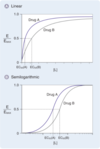Pharmacodynamics Flashcards
how do drugs exert their effect
- drugs (ligands) initiate, enhance, diminish or terminate biological pathways by binding to receptors on PM of calls
- receptor is the target
- must have adequate size, charge, shape and atomic composition
What is the receptor-effector system?
- signal transduction pathway
- the receptor its cellular target and intermediary molecules make up this pathway
the effect of the drug is proportional to what?
percentage of receptors occupied by drug
fraction of drug receptors occupied by the drug is dependent on drug concentration in the extracellular fluid
what is the limit range for the size of drugs?
- lower limit = 100 MW (minimum size needed to impart specificity of action
- upper limit = 1000 MW: limit allowing reasonable movement throughout the body to sites of action
*note large drugs need to be injected directly into compartments
Drugs that mind to receptor through weak bonds must___
be more selective and require precise fit if an interaction is to occur
4 types of drug receptors
ion channels, G-protein couples receptor, enzyme-linked, receptor, intracelular receptor

Describe ion channel
- a drug binds to ion channel that spans the cell membrane
- causes change in conductance
describe G-protein couples receptor
- Heptahelical receptors spanning the plasma membrane
- functionally couples to G proteins
- drugs can influence the action by binding to extracellular surfect or transmembrane region of the receptor
describe enyme-linked receptor
- drug can bind to extracellular domain of a transmembrane receptor and cause a change in signaling within the cell by activatnig or inhibiting an enzymatic intracellular domain of the same receptor
Describe intracellular receptor
- drugs diffuse through the plasma membrane and bind to cytoplasmic or nuclear receptors
- many lipophilic drugs use this pathway (drugs that bind to steroid hormone receptors like estrogen and progesterone receptors_
- some drugs can inhibit enzymes in the extracellular space without crossing the plasma membrane
What are the two states of a drug receptor
- most drugs act on receptors that have an endogenous ligand (neurotransmitters and hormones)
- many receptors have active and inactive state existing in reversible equilibrium
- many drugs function as ligands for these receptors by influencing the probabilty that they are in the active or inactive state
what is an agonist
- a drug that upon binding favours the active conformation
- full agonist activates to maximal extent possible

what is an antagonist
0 drug that prevents agonist-induced activation of the receptor
- inhibits the ability of target to be activated or inactivated by physiologic or pharmacologic agonists

what are partial and inverse agonists
- do not fit into agonist or antagonist
- partial agonist produces a submaximal response upon binding
- inverse cause constituatively active targets to become inactive

How are pharmacodynamics quantified
- the relationship between the dose (conc) of the drug and the patient’s response to that drug
- *dose response relationship is closely related to drug-receptor binding relationship for many drugs
what are the two major types of dose-response relationships?
- graded and quantal
- graded describe the effect of various doses of the drug on an individual
- quantal shows effect of various doses on a population of individuals
what are teh axis of the DRC
- dose response curve
- observed drug effect (% maximal response) as function of concentration
how do you find potency and efficacy on the DRC
Potency = EC50: concentration at which drug elicits 50% of maximal response
– comparison of EC50 values between drugs acting at same receptors gives a measure of relative potency
*most potent not necessarily the most efficacious
Efficacy = Emax: maximal response produced by drug
*comparison of maximal respose of drugs at the same receptor gives a measure of relative efficacy
linear vs semilogarithmic dose response curves
A = linear graph of graded dose, B = Semilogarithmic graph od same dose
- EC50 = potency of drug
- Drug A is more potent bc it elicits a half-maximal effect as a lower conc then drug B
- Drug a and B exhibit the same efficacy (same maximal response)

Describe competitive antagomism
- Antagonist has affinity for receptor but no efficacy
- Competes with agonist at site; higher agonist concentration can overcome the effects of a fixed dose of antagonist
- Antagonist produces parallel rightward shift in dose-response curve
- EC50 value larger in presence of antagonist
- Emax remains the same (potency reduced efficacy unaffected)
*when antagonist and antagonist are both competing the max efficacy can still be reached, just need a higher conc of agonist so dose-response shifts to the right

Describe Non-competative antagonism
- antagonist very slowly dissociates or is irreversible bound
- also causes a rightward shift to DRC
- EC50 value is typically unaffected and Emax is reduced with a non-competative antagonist
- no matter how much drug you administer cant rich maximum response
(efficacy decreases, potency unchanges)

What is desensitization
- effect of a drug often diminishes when given repeatedly
- tolerance = the gradual decrease in responsiveness to chronic drug administration
what are possible mechanisms for desensitization
- temporary inaccessibility of receptor by phosphorylation
- sequestration of receptors in cell by internalization
- Reduce synthesis of new receptors


